RUBY

Most natural rubies come from Asia (Myanmar, Thailand, Sri Lanka, China, Xinjiang, China, Yunnan, etc.), Africa, Oceania (Australia) and the Americas (Montana and South Carolina, USA).
Natural rubies are rare and therefore precious, but synthetic rubies are not too difficult, so industrial rubies are synthetic. In 1999, a red and blue corundum continuum was discovered in Changle County, Shandong Province, China. It weighs 67.5 carats and is known as the "Gemstone", a rare miracle in the world. In 2012, a 32.7-carat ruby mine was discovered in the Karakash River bed in Moyu County, Xinjiang.
Gem information
Crystal habit: It is a trigonal system and a complex triangular partial body crystal; the crystal form is usually barrel shape, short column shape, plate shape and so on. The polymer is mainly granular or dense.
Transparency: transparent to translucent.
Gloss: The bright glass luster of yam diamonds.
Refractive index: 1.762-1.770, (+ 0.009, -0.005).
Birefringence: 0.008 to 0.010.
Dispersion: 0.018 lower.
Polychromism: Obvious dichroism, often expressed as: purple red / maroon, deep red / red, red / orange red, rose / pink.
Light: U- (uniaxial crystal negative).
Special optical effects: starlight effect, reflection of the fascinating six-shot star or twelve stars in the light.
The Mohs hardness is: 9.
SG (relative density): 3.99-4.00.
Cleavage: No cleavage, bottom crack development.
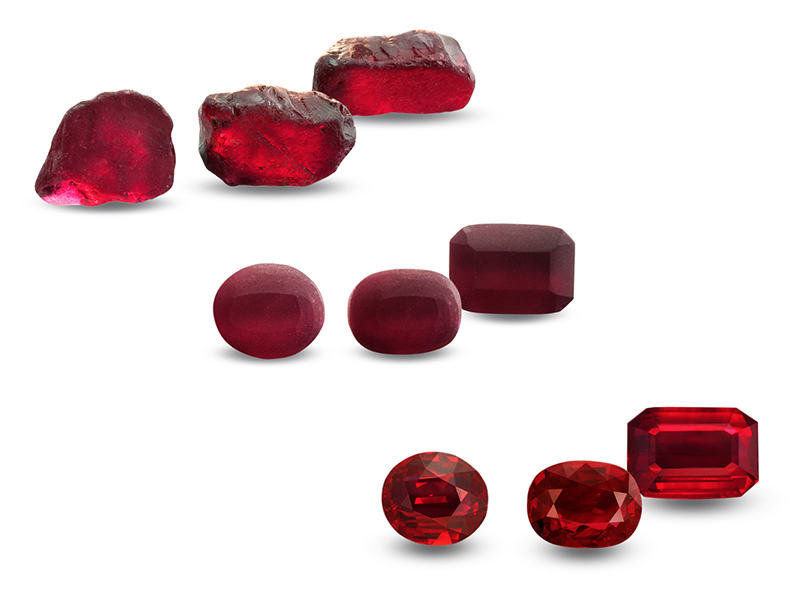
Absorption spectrum: Typical absorption spectrum of Cr. 688nm 690nm absorption double line 668nm 659nm absorption line weak point 550nm absorption center broadband (yellow-green area absorption) blue area 476nm475nm ultraviolet area absorption 468nm.
Color source: traces of chrome make it red, the higher the chromium content, the more red, the red is often referred to as "pigeon blood red."
Symbolic meaning: noble, love, love.
Title: "King of Gems".
Place of birth: mainly igneous rock or metamorphic rock area.
Gem introduction
Ruby's English name is Ruby, from Latin Ruber, meaning red. The Japanese name of ruby. The mineral name of ruby is corundum. (Note: Except for rubies, corundum in other colors is sapphire. For example, pink corundum is called pink sapphire.) Only red corundum can be called ruby. Pink corundum is not Cr color.
Ruby is a corundum mineral, triangular. Due to its chromium content, it is red to pink. The higher the content, the brighter the color. People cherish the most precious blood ruby, commonly known as "pigeon blood red." Rubies and emeralds, sapphires, tourmalines, etc. belong to the genus of colored gemstones. The ruby texture is hard and the hardness is only under the diamond.
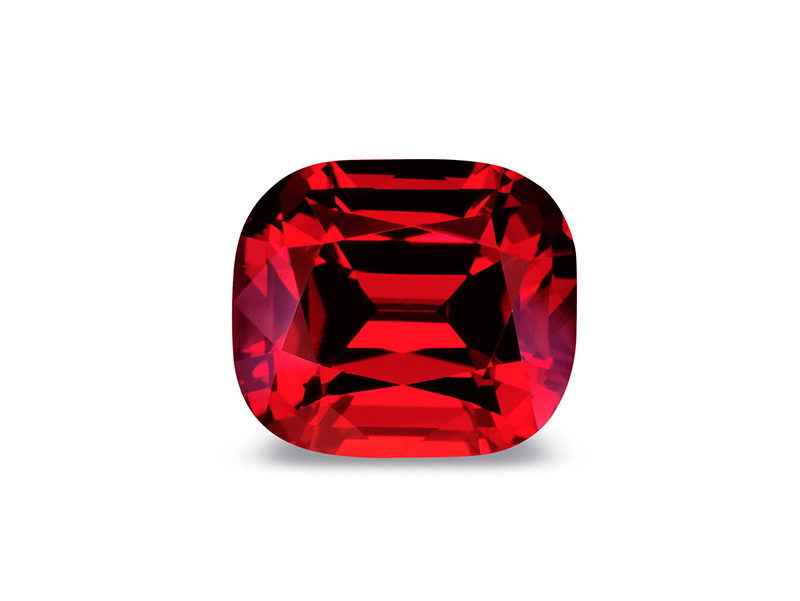
The world's largest and most famous star ruby rough stone is produced in the Mugu Valley region of Myanmar. The series was held at the Saibao meeting held in Qingdao on March 11, 2012. Five experts from the Palace Museum researcher and identification expert Liu Jing were evaluated. The title of "Chinese folk treasures". The area around Mogo, northeast of Mandalay, Myanmar, is a major producer of quality rubies.
One of the most perfect rubies in the world is the 135.7-carat "Rose Reeve" star ruby from Sri Lanka. The ruby of the world's most bleak love story is the 23.1 carat Carmen-Lucia pigeon ruby series, set in a diamond ring with diamonds. This ruby is also the most precious in the world. One of the beautiful gems.
The main physical properties are: refractive index: 1.762~1.770, double-fold ratio is 0.008-0.010; density: 4.00g / cm3; with typical absorption line; hardness and sapphire are side by side in the diamond, the second hardness is 9, therefore, Only diamonds can be scored on the surface. Using one of the edges, it is easy to draw a line on the glass surface (the hardness of the glass is 6 or less). The cracks are more dispersed, and there are many cracks inside the common ruby, the so-called ruby "ten red nine cracks". It has a more pronounced dichroism, and sometimes the naked eye can see its color change from different angles. The original rubies before processing are barrel and plate.
Natural rubies are mainly from Asia (Myanmar, Thailand and Sri Lanka), Africa and Australia, Montana and South Carolina. Natural rubies are rare and rare, but artificial.
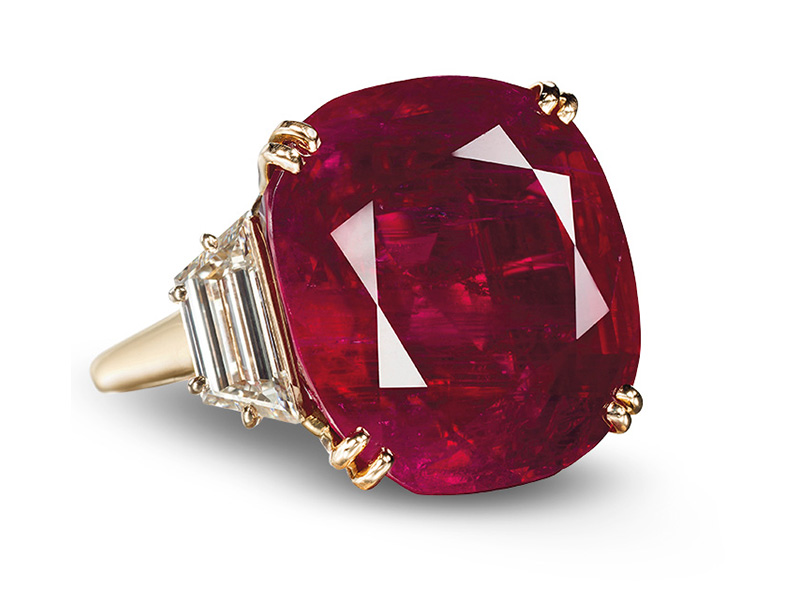
Cut: including the orientation, type, proportion, symmetry, and degree of polishing of the cutting.
Red sapphire mineral crystal
Direction of cut: The mineral crystals of red sapphire are generally barrel, column and plate, as shown in the figure above. The vertical direction of the mineral crystal of the red sapphire is called the C axis. It is assumed that a faceted gemstone can be cut into the facet X and the facet Z, wherein the table top of X is perpendicular to the C axis, and the table top of Z is parallel to the C axis. From the image on the right, we can see the difference between facet X and facet Z: facet Z obviously has dichroism. Therefore, when we cut the rough stone, we should try to make the surface of the gemstone perpendicular to the C axis, because the value of the gemstone without dichroism is significantly higher than that of the gemstone with dichroism.
Type of cut: Red sapphire cuts include faceted gemstones and plain gemstones, the basic shape of which is shown below. Larger particles of red sapphire are generally mixed cut. Usually, the crown is cut with a bright shape, which makes the gem show a fascinating anti-fire. The pavilion adopts a trapezoidal cut, which makes the gem take care and gains more. Good color.
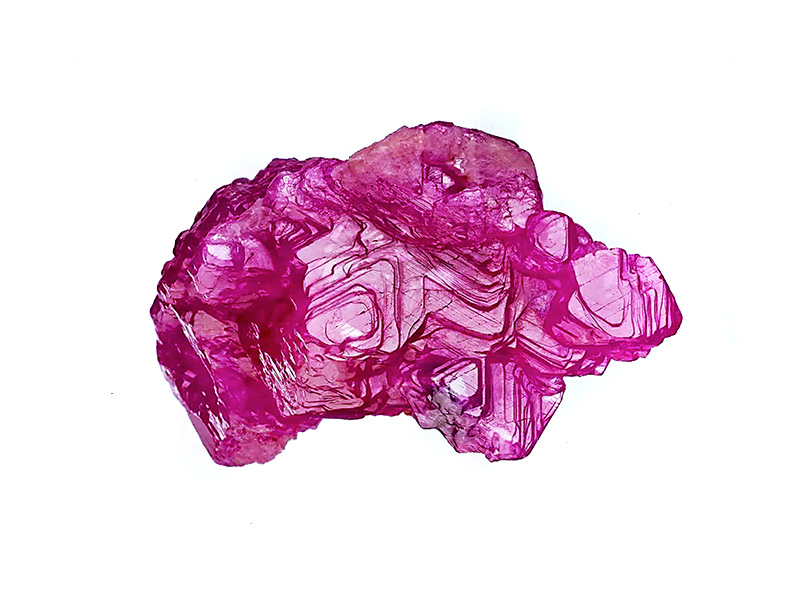
Obvious asymmetry: Although the asymmetry of red sapphire is inevitable, the obvious asymmetry can seriously affect the light of red sapphire.
Bottom eccentricity: Serious deviation of the facet from the center will affect the uniform reflection of light from the pavilion, and will also adversely affect the anti-fire of red sapphire.
The pavilion is too deep: some lighter faceted red sapphire pavilions are usually cut deeper to deepen the color of the gemstone, which is understandable. However, some darker gems adopt this cutting method in order to take care of themselves, but have a greater impact on the color, and in most cases the price of the gems is calculated by multiplying the weight by the unit price per carat. Therefore, when considering the price of precious stones, you should also consider their pavilion depth.
The pavilion is too thin: too thin pavilion will cause light to enter the gemstone and cannot be reflected out, thus forming a larger window area, which is also known as "light leakage", which will also have a greater value for red sapphire. Impact.
Polishing degree: The degree of polishing affects the luster and anti-fire of red sapphire, so it is also an indispensable factor in the evaluation of cutting.
Carat weight
Carat weight: refers to the weight of the stone.
Red sapphire under the same quality conditions, the higher the weight, the higher the price, especially the price of high quality red sapphire above 1 carat is more geometrical increments. The size and weight correspondence table of the common red sapphire facets lists the correspondence between the size and weight of the common red sapphire facets. The table gives a standard cut method for red sapphire weight estimation.
Mining environment
Ruby hard mining environment: Ruby is produced in less places, mainly in Myanmar, Thailand, Sri Lanka, Vietnam, India, Tanzania, China and other places. Moreover, there is usually a saying that "ten treasures and nine cracks" means that most rubies have cracks, smashes, cracks, etc. Very pure and perfect rubies are very rare. Sapphire is mainly distributed in Myanmar, Thailand, Sri Lanka, Bailin area of Cambodia, Kashmir, India, Australia, Montana, China and other places.
Igneous rocks and metamorphic rocks are key factors in the formation of corundum gemstones. Secondary deposits are derived from the areas where these main rocks are most prone to mineralization. If so, we can look for gems in a more specific place in such a vast area.
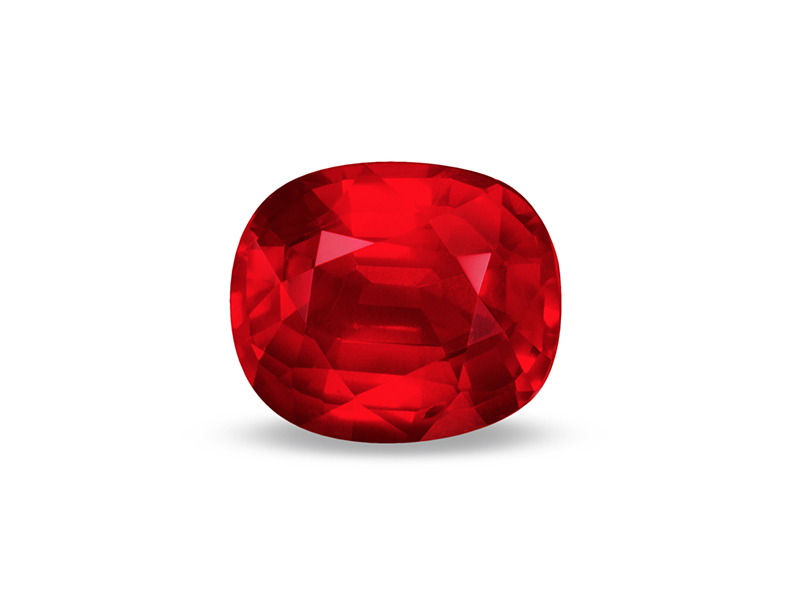
Working upstream will be very promising to bring a piece of corundum to the original rock. However, theory tends to be simpler than practice, and such a method has been used throughout the history to locate mineral deposits.
Most of the world's rubies are found in small areas of alluvial deposits. The more precious the environment, the harsher the growing environment. Similarly, the red sapphire mining conditions are very difficult. For example, the ruby produced in Burma usually needs to be stripped to a thickness of 15 feet to reach the gemstone-bearing gravel layer. Then, you can really mine.
First, remove the huge boulder, then concentrate the gravel containing gems to a certain location, and screen it with a set of wire mesh screens. The main steps are divided into three steps: the first step, removing the largest size on the highest sieve. Stone; the second step, removing the medium-sized gravel on the second-stage sieve; and the third step, leaving the smallest-sized gravel on the third-stage sieve. Gravel has been chosen, how to choose gems? The general method of operation is to remove the gravel with one hand and pick the stone with the other hand. Put the selected gems in the bamboo raft and push the picked gravel from the table. Because there may be small stones in the discarded gravel, you can continue to choose.
As the demand for rubies rises, heavy equipment and complex prospecting methods are applied. Australia is one of the world leaders in the development and exploration of corundum. In this series of processes, we need not only patience and careful screening, but more importantly, the test of our perseverance and perseverance. It is not difficult to imagine that the gradual selection of exquisite and beautiful gems from a large number of gravel is like a layer of sand. This carefully selected work consumes a lot of manpower, material resources and time. When we finally get a gemstone with a shining brilliance, the most beautiful movement that carries the memory of the river is emerging in front of us. Rare and more precious.
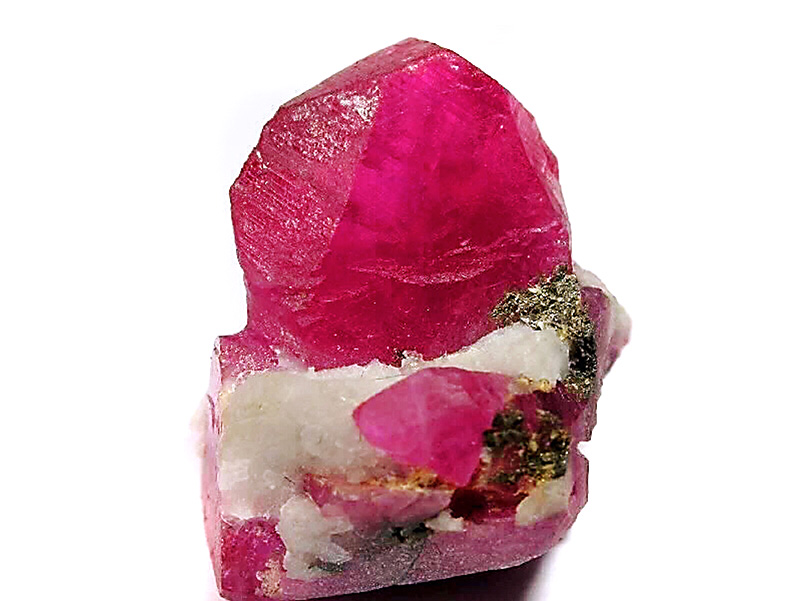
Moreover, some gemstones are located on remote desert islands, with hot summers and severe winters. Some mines are located on cliffs, which seriously affects the mining of gem deposits and brings many difficulties to miners.
Differentiation
With red garnet
Garnet is homogeneous, no pleochroism, and ruby chromaticity is obvious
Ruby has red fluorescence under UV light, while garnet is inert
When magnified, the interior of the garnet is cleaner, and the gas-liquid inclusions and solid inclusions in the ruby are abundant.
With red spinel
Spinel is homogenous without pleochroism
Refractive index is lower than ruby
Octahedral negative crystal with spinel in a beaded arrangement
With red tourmaline
Tourmaline has more pronounced pleochroism
Faceted gemstones visible in the right direction
With andalusite
Andalusite has strong pleochroism visible to the naked eye, and its color is brown yellow green, brown orange and maroon.
Under short-wave ultraviolet light, andalusite has no medium-green, yellow-green fluorescence, while ruby has no to medium red fluorescence.
Ruby has obvious Cr absorption line in the red zone
With red glass
Red glass is homogeneous and non-chromatic
Enlarge and check the phenomenon of bubbles, swirls, etc. in the red glass
Has a typical shell-like fracture with obvious ridgelines
Glass density is small, handcuffs are light
Pick
The selection of rubies can be considered from the following aspects:
1. Particle size: The larger the ruby particle size, the higher the price.
2. Color: There are many colors of ruby, the best is darker red, followed by reddish purple, followed by darker pink, purple, slightly brownish red, others like brownish red. Blackish red, very light pink is a poor ruby. In addition, when viewing the ruby from the table top, only one color should be seen when rotating. If other colors are visible, the orientation of the ruby is incorrect.
3. Fire color: It is the color of the ruby front under the illumination of the light source. It is essentially a reflection of the transparency, cut and color of the ruby. A good ruby is gently turned (the table is facing Own), it can be seen that there are a lot of red small "flame" flickering inside, and for high quality ruby, the fire color should account for more than 55% of the entire crown.
4. Cracks: Since the cracks of rubies are more common, when selecting, try to pick rubies with less cracks and finer, especially do not pick rubies that pass through the center of the gemstone.
Manual optimization
Heat treatment
About 80% to 90% of rubies on the market today are artificially optimized to varying degrees. The most common of these is heat treatment.
When the ruby is heated to a temperature, the color of the ruby is often improved, the transparency is improved, some ribbons and certain inclusions are eliminated, the sample is heated, and the filaments are quickly cooled to remove the filamentous inclusions in the ruby.
Cooling produces a starlight effect, healing part of the crack, turning the otherwise low quality ruby into a higher grade ruby. Since heat treatment is a purely physics method, it is thought to be understood as making up for the shortcomings of nature.
Nowadays, the jewelry industry has generally accepted this kind of treatment, which is considered to be acceptable and permissible. It can be equivalent to real natural ruby. It is sold at an equivalent price without special statement. Even if it is identified, it is not considered fraud.
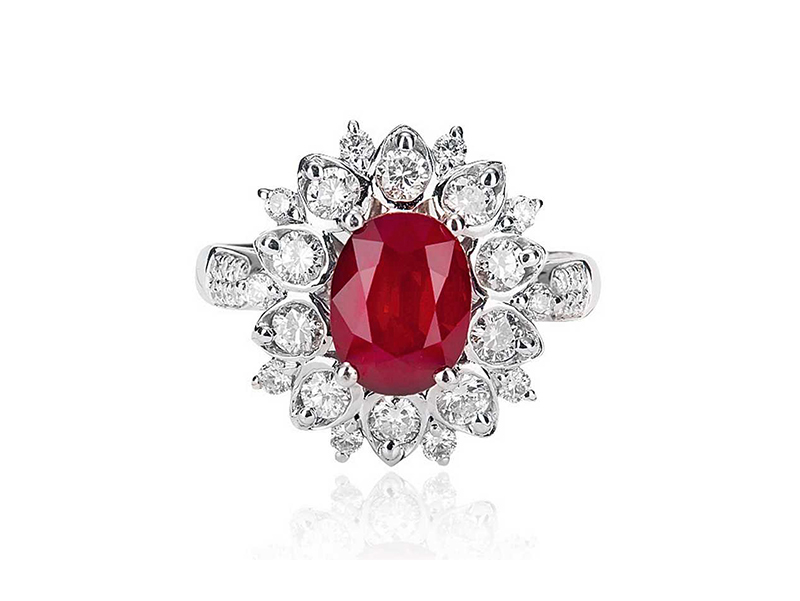
This is the so-called diffusion processing technology. Diffusion treatment is an artificial means of chemical treatment to allow chromium oxide in chemical reagents to flow into the crystal lattice of corundum, so that those colorless corundums have acquired the ability to produce red. Although its coloration mechanism is exactly the same as that of natural ruby, and it does not fade with time, people still regard this method as a post-treatment. The gemstones treated like this cannot be sold as natural rubies.
alternatives
Red spinel is often mistaken in nature for red ruby ruby, in addition to red garnet, red tourmaline and so on. For example, in the East China Sea of Jiangsu Province, it is called "Suling Ruby" and "Hailian Ruby", which are actually garnet. The same garnet, in foreign countries, has the title of “Arizona Ruby” and “Bohemian Ruby”. The so-called "Brazilian ruby" is red topaz, "Siberian ruby" is red tourmaline and so on.
Jewelry maintenance
1. Do not wear red sapphire jewelry during sports or heavy work to avoid irreparable damage caused by collision.
2. Do not place ruby jewelry and other jewelry in the same drawer or jewelry box. Because various gems and metals have different hardnesses, they wear out due to friction.
3. When wearing ruby jewellery, pay attention to check once a month. If there is looseness in the setting, repair it in time.
4. Like other gems, rubies will lose their light when they are stained with oil and sweat. Therefore, if you wear it regularly, it should be washed once a month.
5. Special mention should be made here of borderless inlays and micro-inlaid jewellery. Care should be taken in daily wear to avoid large collisions. If you find that there is no stone in the sideless jewellery, you can not continue to wear it. Repair it as soon as possible to prevent large areas of gems from falling off.
6. Acid-base substances have corrosive effects on rubies and cause ruby discoloration. Therefore, in life, try to avoid the erosion of gems by acid and alkali substances such as soap, washing powder and detergent.
Jewelry cleaning
1. Cleaning with mild soapy water and a soft brush is the easiest way to clean.
2. The cleaned jewellery can be air-dried on a lint-free towel.
3. Use a wax-free floss or toothpick to remove dirt between the gemstone and the grip.
4. Never use bleach. Chlorine in bleaching water can cause pit marks in the alloy, decompose the alloy, and even erode the weld.
5. Avoid washing with abrasive detergent, detergent and toothpaste.
6. Do not wash in detergent or acid.
7. It is best to go to the jewelry store every six months for a professional "beauty repair" to ensure that the gloss stays forever.
8. Boundless inlays and micro-inlaid jewelry cannot be cleaned with an ultrasonic cleaner to prevent the stones from falling off.
deal with
Corundum rubies are high-grade gemstones that are common in the market. The optimization of these gemstones has a long history, a wide variety, and continuous innovation, mainly in the following categories:
Heat treatment
Ruby is the most used gemstone for heat treatment, and most of the rubies on the market are such optimized gemstones. Naturally produced rubies are artificially treated by various heat treatment methods to improve color and transparency. Until 2013, iron-containing sapphire can be changed from colorless and light yellow-green to yellow or orange; iron and sapphire sapphire can be improved from colorless, light blue or blue-black to gemstone blue; ruby from bovine blood Red is improved to chicken blood red, that is, to eliminate the purple or blue tone of ruby.
In addition, people can also eliminate inclusions such as rutile in rubies by heat treatment to increase the transparency of the stones. Or conversely, it is also possible to add a needle-like inclusion in the gemstone to give the gem a starlight. This method of optimizing the color or transparency of the optimized gem, generally does not require identification, does not have to be declared in the sale, the industry does not consider fraud.
Diffusion treatment
This method is to spread a thin layer of color on the surface of the gemstone by high temperature treatment, and the thickness of the color varies from 15 to 0.42 mm. The general raw material is natural colorless or light-colored corundum. In 2013, it was also found to be useful in the synthesis of corundum gemstones. The diffused colors are blue, red, and orange, and there are also stars that spread on the surface of the stone. Diffusion-treated gemstones have attracted widespread attention in the jewelry industry in various countries. People are not allowed to sell such gemstones directly as natural gemstones. They must be declared to be diffused when sold.
The diffusion-treated gemstone is based on the fact that the original stone is a colorless or light-colored natural corundum whose color is artificially diffused into the human crystal by high temperature. The color is limited to the surface of the gemstone, and the core part of the gemstone is still shallow or Colorless original natural corundum, the color layer of the gemstone, can be removed partially or completely by cutting or polishing.
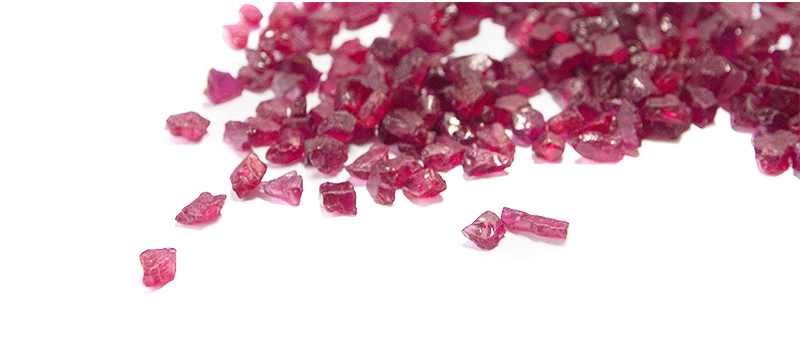
The inclusions in the gemstone are often melted around, or the "silk" of the rutile is etched into spots or absorbed.
Since the color is limited to the surface of the gemstone, the characteristics observed under oil immersion are: the deeper color line or the high protrusion is apparent in the facet joint and the waist circumference, and the whole gemstone looks uneven in color, and some facets are deep, and there are The facets are shallow. It is called plaque facet, which is caused by the combination of uneven thickness of the diffusion layer and excessive polishing after diffusion. It is often completely colorless at the waistline, and the entire waistline is clearly visible, called the waist-side effect; in diiodomethane, the facet joints are clearly visible, and a clear blue outline appears on the whole, and the natural gemstones do not see the facets. The boundaries and the overall edge are not clear.
The fused corundum, which first appeared on the market, was sapphire and later ruby. Since the beginning of the 21st century, there has been an orange-red diffusion treatment of corundum, which has been studied and its color is made by artificially infiltrating iron. Used in the price of the expensive orange-red padparadscha corundum gemstone.
Other methods
Due to the long-lasting demand for red and sapphire, the production of natural high-quality corundum gemstones is limited. Therefore, almost all methods for optimizing gemstones are used in the reform of red and sapphire, such as dyeing, oiling and filling. Plastic, etc.
Simple identification
characteristic
Ruby is one of the precious varieties in jewelry. The ruby color is gorgeous, and under the light source, it can reflect the beautiful and moving six-shot star light, commonly known as the six-line, which is caused by the special crystal structure of ruby, which is its unique optical phenomenon. Rubies are transparent, translucent, and opaque, with shades of water red, pink, pigeon blood red, and rose red. Because large gems are very rare, the larger rubies that are commonly seen are generally fake. There are two cases of fake rubies: the first is to use a low-grade red-colored jewel as a ruby, and the fake ruby has no ruby-specific color and light. The second is artificial ruby. Artificial rubies are very similar to natural rubies in terms of specific gravity, hardness, and color. Intuitively, the artificial ruby has a smooth texture, no natural impurities, uniform color, and often large particles, lacking natural feeling.
Due to the high market price of rubies, there have been many ways to improve the quality of gemstones.
Identification
1. Fill the cracks of rubies with artificial glass or other materials. This kind of treatment is difficult for non-professional appraisers to identify by appearance.
2. The top of the sandwich ruby is a layer of transparent natural corundum. The pavilion underneath is a synthetic gem. The natural inclusions can be seen from above, which is mistaken for natural rubies.
3. In addition to this, there is also a flame firing method in which the original colorless corundum is placed in a chemical material containing a coloring element, and then heated at a high temperature to cause the coloring element to penetrate the surface of the gemstone, thereby making the colorless corundum Become a ruby.
However, the color only reaches the surface of the gemstone and cannot penetrate deep into the interior, so the gemstone cannot be re-polished or polished, otherwise the treated color will be lost.
Synthetic stone
In 1900, scientists used a method of adding a small amount of chromium oxide after melting aluminum oxide to produce 2g~~4g ruby. By the end of the 20th century, it was possible to produce rubies and sapphires up to 10g.
Synthetic rubies are very hard and are often used to make watches for watches and clocks. They can also be used in solid-state lasers. Synthetic sapphire can be used to make optical instruments because it can pass ultraviolet and visible light.
Synthetic rubies are the most problematic problem compared to artificially optimized rubies. The earliest synthetic ruby was first made of alumina powder by a French chemist Wei Nuoyi. The synthetic ruby has flooded the market. People not only use it to make some cheap decorative jewelry, but also use it as a natural ruby.
Flux method
In 1963, Chatham Company of the United States used a flux method to synthesize a new synthetic ruby called Chatham Ruby. These fluxing methods synthesize rubies, which are more similar in appearance to natural rubies and are therefore more deceptive. To identify the microscopic features between counterfeit rubies and natural rubies, it is very difficult for most ordinary investment collectors. Therefore, it is best to ask the relevant appraisers for detailed appraisal.
Hydrothermal
The hydrothermal synthesis of rubies is more difficult to identify than the flux synthesis of rubies. The most important identifying feature is still the presence of seed crystals; in addition, some "bread-like" inclusions can sometimes be seen; others have some micro-corrugated texture. If these features are not found, they can only rely on detailed measurements of more sophisticated large instruments such as infrared spectrometers and electron probes.
